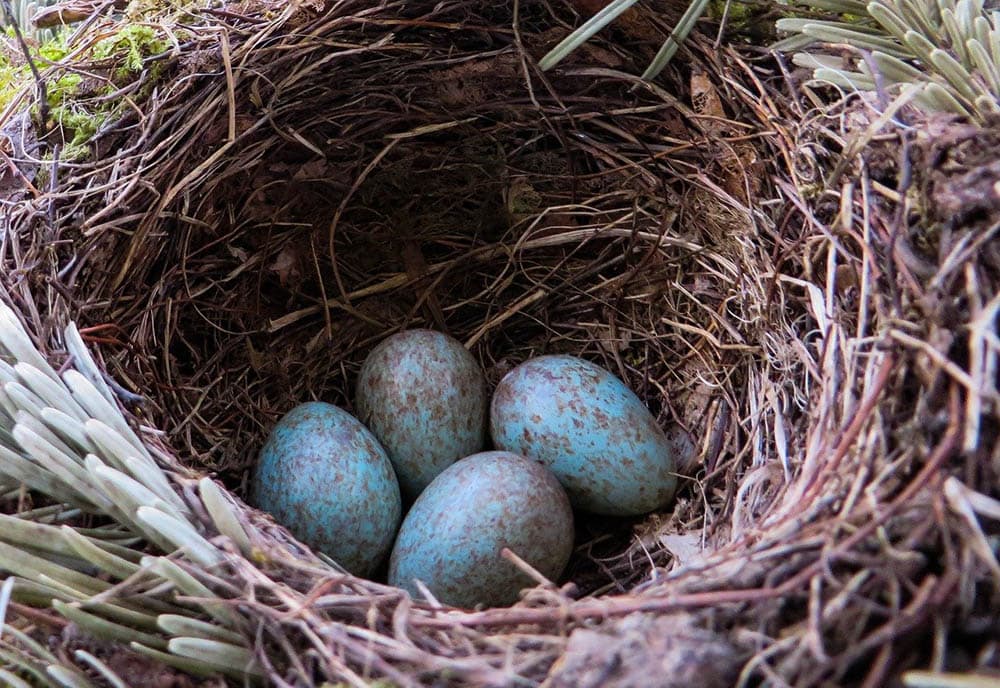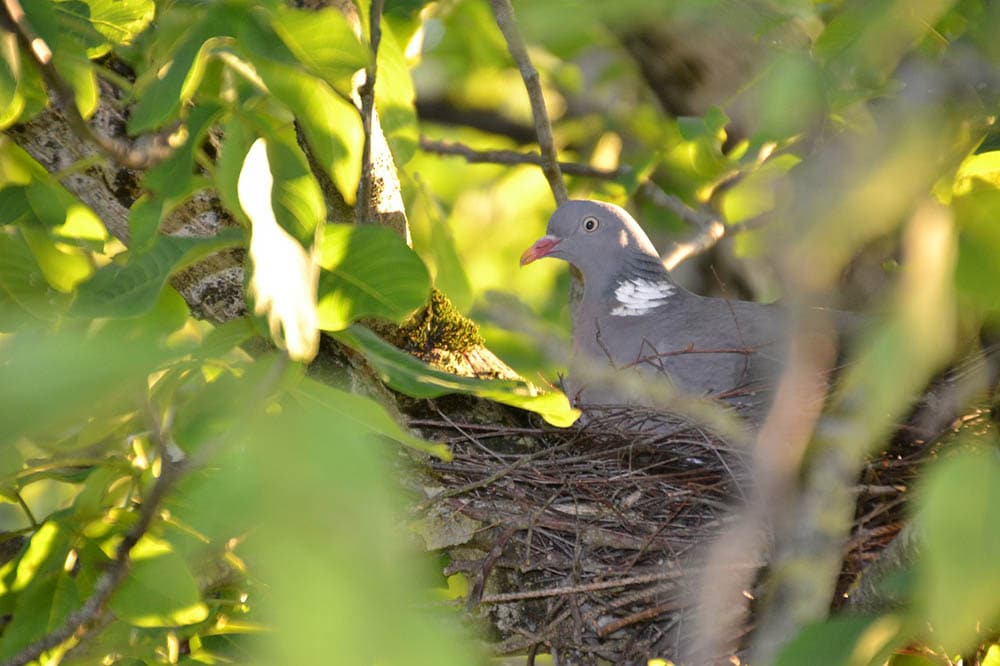Can You Move a Bird’s Nest? Here’s What You Need to Know!
Last Updated on

Whether or not you can move a bird’s nest depends on many factors. As a rule of thumb, you cannot move the nest if the mother is brooding or eggs are laid. In contrast, you can move the nest if the mother is not brooding yet or all of the hatchlings have left. Talking to a professional might be the best way to determine if you are allowed to move the nest.
Because there are legal ramifications of moving a bird’s nest prematurely, it’s imperative that you have all of the information upfront about when you are able to do so. Below, we’ll discuss the most critical information about determining whether or not you can move a bird’s nest.

Moving a Bird’s Nest 101
Moving a bird’s nest is not as simple as you might think. Even if there are no eggs present in the nest yet, you still might not be able to mess with the nest. In fact, there are actual laws that prohibit the removal of certain nests.
According to the Migratory Bird Treaty Act of 1918, more than 800 birds are protected in our country. Basically, every bird that is frequently in your yard is protected by this act, which means you cannot interfere with any active nests.
Active nests are defined as any nest that either has eggs already in it or has a brooding mother. A brooding mother means that the mother bird is actually sitting on the nest, even if no eggs are laid.
As a homeowner, your options are limited if you see an active nest on your property. Generally, you should not move the nest. If the nest must be moved for safety reasons, you have to contact a local rescue organization to do it for you.

When You Can Move a Bird’s Nest
If you need to move a bird’s nest, there are two main situations when you can do so: if the nest is inactive or a safety hazard calls for the nest to be removed.
If The Nest Is Inactive
You are free to move a bird’s nest anytime it is not active. So, you can move the nest if there are no eggs in it or if the mother is not brooding. Active nests are typically seen in the springtime whenever it is nesting season, but they may continue into the summer. By fall and winter, most nests are safe to be removed.
In the springtime, you can move a nest if it is not active yet. Most birds take a couple of days to build their nest. If you catch it whenever the bird is still making the nest, you are free to move it. You will want to use preventative measures so that the bird does not come back, such as bird spikes.
To determine if you can move the nest, watch it for a few days before you decide to move it. This will give you a chance to see if there are any eggs, hatchlings, or brooding going on. If you don’t see any of these things, you are free to move the bird’s nest.
That being said, it’s always best to leave a nest be, even if it is inactive. Many birds prefer to use the same nest for years to come, and other birds will build onto the nest. Leaving the nest be makes the momma bird’s job a bit easier from year to year.
The Nest Must Be Removed
There are some incidents when the nest needs to be removed, even if it is active. For example, a nest in the gutter will need to be removed since the nest is going to be destroyed by water flow if it is not removed. The nest will also need removal if it is in the chimney. In these situations, the bird’s nest can be removed, but you cannot remove it yourself.
Instead, contact a bird rescue organization. They will be able to inspect the nest to determine if it needs to be removed. If they agree with your consensus, they will help you fill out permits to allow you to safely remove the nest.
Only remove an active bird nest with the help of a rescue organization. They will ensure that everything is completely legal and safe for the birds in question.

When You Cannot Move a Bird’s Nest
Generally speaking, you cannot move a bird’s nest if it is active. Once again, an active bird’s nest is one where eggs are laid or the mother is brooding. In either case, it is actually against the law to move the bird’s nest without a permit.
Simply leave these nests be until the mother and hatchlings all fly away. The only time you can move an active bird’s nest is if the safety of the birds and your home are in question. Even then, you cannot remove the nest yourself. You have to contact a professional organization to help you with the process.

How To Move a Bird’s Nest
Whenever the nest is no longer active, you are free to move it, but moving it is not absolutely necessary. Many birds will nest in the same area or the same nest the next year. If the nest is not bothering you, it’s always best to leave it be. However, we understand that isn’t always an option.
If you need to move the nest after it is no longer active, here’s what you need to do:
1. Double Check The Nest
Even if you are fairly certain that the nest is no longer active, double-check to confirm. If you see adult birds sitting on the nest or hear baby birds in it, do not move on to the next steps. Only move on if you confirm that the nest is inactive.
2. Protect Yourself
Once you confirm that the nest isn’t active, protect yourself by putting on gloves. Although you are unlikely to develop a disease from disposing of a bird’s nest, it’s always best to be safe than sorry. Consider wearing a facial mask as well.
3. Dispose Of The Nest
Dispose of the nest by throwing it away in a trash bag. You don’t need to do anything special during the disposal process.
4. Prevent The Birds From Coming Back
If you do not want birds to nest in that spot again, you will have to do some preventative measures. Using screens or bird spikes are some of the best ways to prevent birds from nesting around your home.
Contact a Professional For Help
Anytime you are dealing with a bird’s nest, it’s always a great idea to consider contacting a professional first. A professional will help to determine if the nest is inactive. If the nest isn’t active, they might even dispose of it for you.
In the case that the nest is active, they can help to determine if the nest location is a safety hazard. If the location is a safety hazard, they have the permits and capabilities to remove the nest despite it being active. Otherwise, they will tell you to leave the nest be until it is inactive.
Related Read: 12 Birds That Make Mud Nests (with Pictures)

Conclusion
You can move a bird’s nest, but the nest must be inactive. Even so, it’s still a good idea to even let inactive nests stay where they are so future birds have a place to roost. The only time you should remove an active nest is if there is a safety hazard for your home or the bird.
As for the removal process, you can remove a bird’s nest yourself if it is inactive. If the nest is active and poses a safety hazard, contact a rescue organization in your area. They have the permits and capabilities to remove an active nest within the bounds of the law.
If you can handle it, it’s always best to leave a nest where it is, regardless of whether it is active or inactive. It provides birds a place to nest in the future, and you don’t have to worry about whether or not hatchlings are present.
Featured Image Credit: foto-augenblick, Pixabay
About the Author Robert Sparks
Robert’s obsession with all things optical started early in life, when his optician father would bring home prototypes for Robert to play with. Nowadays, Robert is dedicated to helping others find the right optics for their needs. His hobbies include astronomy, astrophysics, and model building. Originally from Newark, NJ, he resides in Santa Fe, New Mexico, where the nighttime skies are filled with glittering stars.
Related Articles:
Can You Use Binoculars to Look At Stars? How to Choose the Right Pair
10 Types of Hummingbirds in Arkansas (With Pictures)
8 Types of Hummingbirds in Nebraska (With Pictures)
5 Types of Hummingbirds in Idaho (With Pictures)
3 Types of Hummingbirds in Mississippi (With Pictures)
8 Types of Hummingbirds in Kansas (With Pictures)
5 Types of Hummingbirds in West Virginia (With Pictures)
5 Types of Hummingbirds in Ohio (With Pictures)
